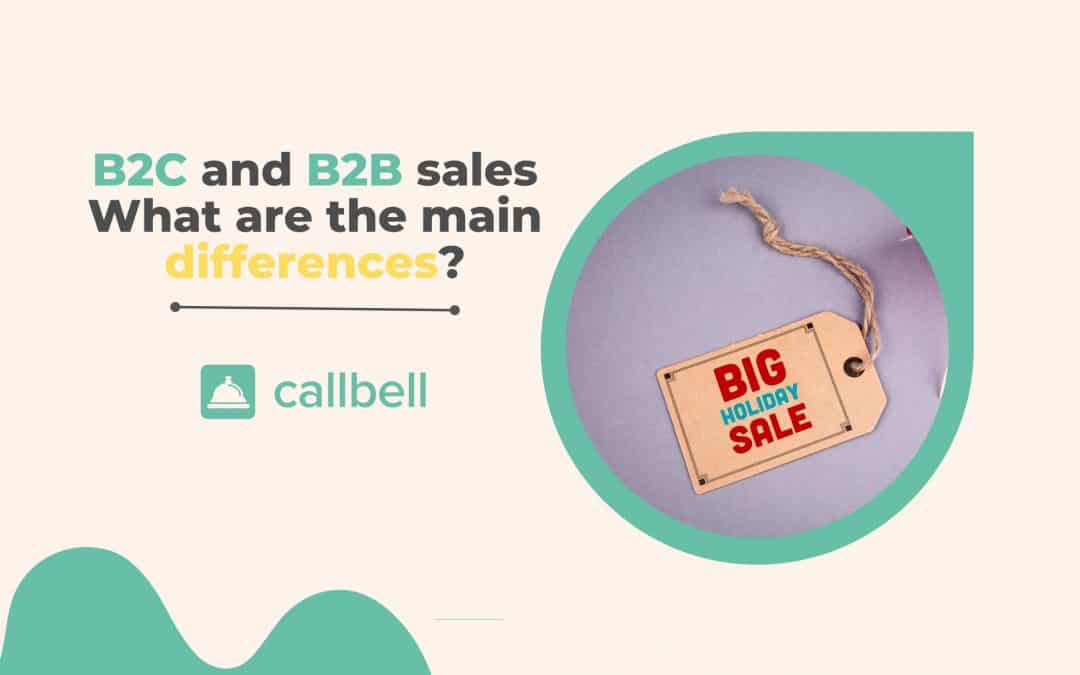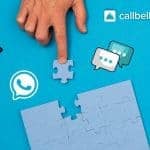If you do not know much about selling, you may not know some of the more popular modes in this industry. Among these we have B2B and B2C, each of them capable of selling to a different type of consumer: the first sells to companies and the second to the final consumer.
Understanding how these two types of modalities work and how they are managed is very important to develop better strategies and methodologies in order to sell in a stable and constant way. This is because the marketing and sales strategies will be specifically aimed at a specific type of consumer.
In this article we will explain why it is essential to understand what type of customer you have, as well as explaining the strategies each model uses to reach their customers. We will show you some companies that apply these types of methodologies, how to apply them to your business versus sales or marketing, and a tool that can help you improve your business results by applying a good strategy for your ideal customer.
From now on we will show you what B2C sales and B2B sales are and what the main differences are.
A B2B business represents all those companies that sell products or services (e.g. podcast promotion companies) to other companies. This can apply to both the digital and the physical world. In digital we can have Callbell as an example: a company that offers communication solutions for companies through messaging apps and social networks.
On the other hand, when it comes to B2B companies in a physical environment, we can imagine all those suppliers offering raw material. It can concern fast food companies or even auto parts distributors, which then offer these items to the final consumer.
As mentioned at the beginning of this article, a company can work with different types of audiences. In the case of the B2C model, the sale or service is intended for the final consumer. Or rather, the person who ultimately uses the product or service he bought.
In this sense we can talk about houses, clothes, food, drinks, electronic items, internet, travel packages, flights, subway tickets, snacks, etc. In reality, there are many types of final consumers depending on the article or service they purchase. But they all revolve around the same idea: they are defined as the person or company who uses the product or service permanently.
This model is extremely interesting, since it is not conventional at all and concerns companies that sell to companies; an element that can vary from suppliers of raw materials to companies that sell communication services, shipping, etc. to other companies that have a B2C model.
Some examples of companies with B2B models are:
a) Communication services: Callbell is a great example of a B2B communication service for companies, since it offers a platform that connects different social networks including Instagram Direct and WhatsApp so that companies can serve their customers from a single place.
b) Wholesale distribution company: they sell food products, cleaning products, clothing, electronic items, etc. to other companies. A good example is Makro, which sells various wholesale items for companies or entrepreneurs.
c) Digital payment services: companies that offer financial solutions for other digital companies. For example, Pay Retailers offering payment solutions to businesses that sell their products and services online.
d) Legal and accounting services: companies that need legal services from lawyers or accounting services.
e) Marketing or sales: companies that need to organize their customer portfolios, social networks or other marketing actions that require CRM or platforms to manage the company’s advertising strategies.
f) Online Store Building Service: Companies or entrepreneurs who wish to build their online stores through these content managers such as Shopify.
For its part, the B2C business model is aimed at end customers as mentioned above. This type of business focuses on providing those products or services to the person who ultimately uses them.
Some examples of B2C models are as follows:
a) Fast food service: food brands or retail products and that the final customer is people like you or me. For example, Burger King, KFC, Farmatodo, etc.
b) Companies with digital services: such as Spotify, Netflix, HBO Max or Disney Plus.
c) Various product chains: such as Walmart, Target, Kroger or Costco.
d) Telephone services: such as Vodafone, T-Mobile, Verizon Wireless or AT&T.
e) Educational services: such as Platzi.
f) Taxi or delivery app: like Uber, Rappi, DiDi, etc.

We can spend hours listing the differences between these two business models. While B2C is dedicated to bringing products and services to the final consumer, the B2B model is responsible for delivering the final product to companies. It can be said that the B2B model is the more profitable of the two. But there are exceptions such as large markets that dominate the B2C model.
Keep in mind that both business models each have their own needs and therefore are sold differently. In the case of B2C, promotions, discounts or 2x1s are very much appreciated. For its part, in B2B the quality, stability, efficiency and, in general, the more durable aspects of the product or service purchased are valued.
We can say that B2C has a greater emotional weight, while B2B follows the more rational line.
A customer who buys a fast-food restaurant does not have the same goals or needs as those who buy communication solutions for a company. Taking this into account is essential to start working on the particularities of your audience.
There are many sales techniques on the market today; however, B2B and B2C sales in general can use 2 types:
Outbound sales: When we talk about outbound we mean selling to people or companies who do not know you, when you try to sell directly.
Inbound sales: When we talk about inbound we mean when leads or potential customers come to you through specific marketing actions by the company.
Each type of model has its different ways of applying this type of methodology. However, in recent years, each of the following companies has been interested in contacting their customers more directly via messaging apps like Instagram Direct or WhatsApp Business.
In the case of the B2B model we have the following techniques:
a) Consultative selling: it involves talking to potential customers to detect their needs and thus offer the best service or product for them.
b) Getting to know your customer: this involves probing or carrying out a small test on your potential customer to get to know him better and have more fluid conversations.
c) Personalized product: the idea in this case is to build the service model your potential customer needs. Typically, each subscription or product is customized for the customer.
d) Direct Selling: The point here is to contact your potential customers via WhatsApp, Instagram Direct, Facebook Messenger or Telegram directly. In order to build a relationship and get the sale.
In the case of the B2C model we have the following techniques:
We have great peculiarities in this sector. Since consumers usually spend a lot of time on social networks like Facebook, Instagram or WhatsApp looking for information, coupons, discounts or contests that they can use to get benefits. This means that their main means of contact with companies are social networks and messaging apps, a model that became very popular after the Covid-19 pandemic.
If you are a B2C business, it means that your biggest market niche is present on social networks. For this reason, you need a tool that can handle the messages that come through your inbound and outbound marketing campaigns. In this sense, you can use Callbell, a tool that connects platforms such as Instagram Direct, WhatsApp Business, Facebook Messenger or Telegram in one place.
The techniques you can use for the B2B model using Callbell can be:
Up Selling: The idea of this strategy is to show your potential customer a product similar to the one he has chosen but with better features. In this way the customer will be able to see that the price difference is not much, but the quality increases.
Cross Selling: the idea of this type of sale is to make the customer who has already purchased a product want to add to the one he already owns.
The idea of all of this is to make customers feel appreciated and paid attention to. This is something extremely necessary in an environment where people talk on WhatsApp and other messaging apps.

Now that you know the differences and the most important points of B2B and B2C sales. What kind of customer or entrepreneur do you want to be?
As mentioned, Callbell is an application that can help you greatly improve the communication potential of your business with customers. It is a communication solution for all those small, medium and large companies that need to centralize all messages in one place with a variety of interesting tools with which to communicate with their customers.
Do you want to know more about Callbell and how it can help your business? Click here.
Frequent Questions
What are the differences between B2B and B2C sales representatives?
We could spend hours listing the differences between these two business models: while B2C is dedicated to bringing products and services to the final consumer, the B2B model is responsible for delivering the final product to companies. Therefore, we can say that the B2B model is the more profitable service. Despite this, there are exceptions such as, for example, the large markets that dominate the B2C model.
It should be borne in mind that both business models have their own needs and, therefore, are sold differently. In the case of B2C, promotions, discounts or 2x1s are particularly popular. On the other hand, in B2B the quality, stability, efficiency and, in general, the more durable aspects of the product or service purchased are valued.
We can say that B2C has a greater emotional weight, unlike B2B which follows a more rational line.
A customer who buys a fast-food restaurant does not have the same goals or needs as those who buy communication solutions for a company. Keeping this in mind is essential to start working on the particularities of your audience.
What is B2B?
A B2B business represents all those companies that sell products or services to other companies. This can apply to both the digital and the physical world. In digital we can have Callbell as an example. Company that offers communication solutions for agencies through messaging apps and social networks.
On the other hand, when we talk about B2B companies in a physical environment, we can imagine all those suppliers offering raw material; such as, for example, fast food companies or even auto parts distributors, which then offer these items to the final consumer.
About the author: Hello! I am Alan and I am the marketing manager at Callbell, the first communication platform designed to help sales and support teams to collaborate and communicate with customers through direct messaging applications such as WhatsApp, Messenger, Telegram and Instagram Direct



